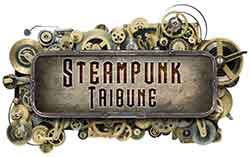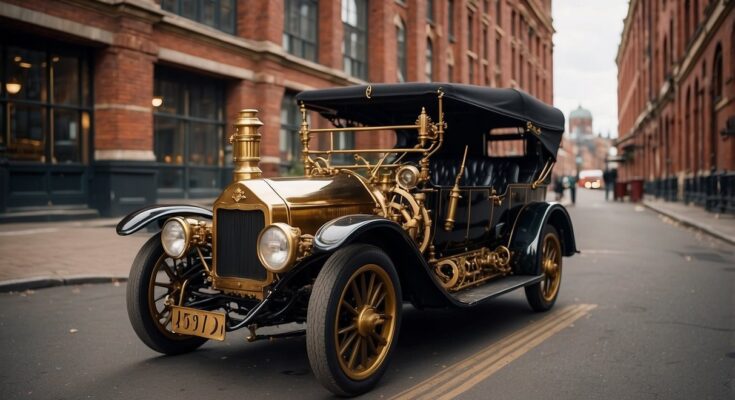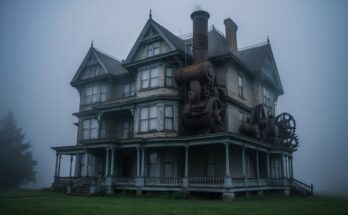Steampunk vehicles embody the imaginative fusion of Victorian aesthetics with advanced steam technology, creating a unique subgenre of science fiction. These vehicles transport enthusiasts to an alternate history where steam power reigns, showcasing intricate designs and art that reflect the beauty of a bygone era. From ornate airships to fantastical automobiles, each creation offers a glimpse into a world where innovation meets artistry.

The allure of steampunk lies not only in its visual appeal but also in its reflection of cultural themes from the Victorian era. This genre challenges conventional industrial progress by reimagining how technology could have evolved through steam and gears. As one explores the various types of steampunk vehicles, they uncover stories that blend adventure, creativity, and a sense of nostalgia.
Through the lens of steampunk, technology is crafted into art, sparking curiosity and inspiring a community of makers and fans alike. Whether one is a seasoned aficionado or new to the genre, the intricacies of steampunk vehicles provide a captivating exploration of history, culture, and imagination.
Steampunk Defined

Steampunk is a subgenre of science fiction and fantasy that draws inspiration from 19th-century industrial steam-powered machinery. It combines a Victorian aesthetic with modern technology, creating a unique blend of art, fashion, and culture.
Origins and Evolution
The origins of steampunk can be traced to the works of authors like Jules Verne and H.G. Wells, who envisioned fantastical devices powered by steam and clockwork. Initially emerging in literature during the 1980s, the term “steampunk” encapsulates a neo-Victorian style that speaks to an alternative history where steam power remains prevalent. The genre evolved as a reaction against contemporary technology, presenting a nostalgic yet dystopian vision of the past. As steampunk gained popularity, it sparked a community of creators who reimagined technology and design through a different lens.
Art and Aesthetics
Steampunk art is characterized by the use of gears, cogs, and Victorian-era motifs. Artists often incorporate brass and copper materials, emphasizing the mechanical aspects of their creations.
Visual elements can include items like clockwork devices, steam engines, and retro-futuristic inventions. Illustrations and sculptures often reflect a world where art meets engineering, creating intricate designs that challenge modern sensibilities. The aesthetic can also extend to the architecture, reminiscent of the Industrial Revolution, featuring ornate ironwork and expansive structures.
Fashion and Accessories
Steampunk fashion draws heavily from Victorian clothing while merging elements of fantasy and functionality. Key items include the top hat, corsets, and goggles, often embellished with gears and leather.
Emphasis is placed on handcrafted accessories, promoting individuality and creativity. layerings, textures, and a mix of modern and historical garments create an eclectic style.
Common accessories include pocket watches, brass jewelry, and steam-powered gadgets, reflecting a time when elegance met innovation. Through fashion, the broader themes of steampunk are explored, emphasizing its unique cultural identity.
Historical Context

The development of steampunk vehicles is deeply rooted in historical advancements and cultural elements from the 19th century. This section explores Great Britain’s role in these innovations, the technological progress of the era, and the cultural landscape of the Victorian period.
Great Britain’s Influence
Great Britain played a pivotal role in the evolution of steam technology during the 19th century. With its vast coal reserves, the country fueled the industrial revolution, leading to significant advances in steam power. The establishment of extensive rail networks and steamship routes facilitated commerce and travel.
This infrastructural growth allowed for increased transportation of goods, ideas, and people, thereby expanding global trade. Furthermore, British inventors and engineers, such as James Watt, made fundamental improvements to steam engines, which became a key component in various steampunk vehicles.
19th Century Innovations
The 19th century marked a time of remarkable innovations, primarily driven by steam technology. In addition to railways and ships, steam-powered carriages emerged, introducing a new mode of land transportation. These vehicles often featured brass fittings, intricate designs, and whimsical aesthetics indicative of the steampunk genre.
Coal, as a primary energy source, enabled the large-scale production of steam engines. The integration of steam power into personal transport led to a blending of functionality and artistry. This era set the groundwork for creative interpretations of vehicles that would define the steampunk movement.
Victorian Era Culture
Victorian culture was characterized by its fascination with science, technology, and the aesthetic of the time. This era inspired a unique blend of romanticism and industrialism, evident in literature and art. Writers such as Jules Verne and H.G. Wells envisioned fantastical machines powered by steam, propelling the imaginations of the public.
Exhibitions and fairs showcased the latest technological advancements, making steam vehicles a symbol of progress. The Victorian obsession with the future, combined with a nostalgia for the past, contributed to the steampunk aesthetic, which thrives on anachronism and elaborate detail.
Steam-Powered Machinery
Steam-powered machinery represents a fascinating intersection of ingenuity and mechanical design. Key forms of this technology include locomotives, automobiles, submarines, airships, and ornithopters, all utilizing steam as their primary energy source.
Locomotives and Trains
Steam locomotives revolutionized land travel in the 19th century. They typically operated using a coal or wood fire to heat water in a boiler, producing steam that powered pistons.
This mechanism turned wheels mounted on axles, propelling the train forward. The iconic Puffing Billy and the majestic Flying Scotsman exemplify this technology, showcasing both power and efficiency.
Additionally, steam trains played a crucial role in industrialization, facilitating the transport of goods across regions. They paved the way for subsequent advancements in rail technology.
Automobiles and Submarines
Steam-powered cars emerged in the late 1800s, with models like the Stanley Steamer gaining popularity. These vehicles often featured large boilers, which could take longer to start than their gasoline counterparts.
Despite their complexity, steam automobiles delivered remarkable torque, suitable for steep inclines.
Steam technology also extended to submarines, where steam engines powered submerged vessels. These submarines, like the Nautilus, used steam turbines for propulsion, enabling new naval capabilities.
The blend of steam power with underwater technology allowed for innovative military strategies during the early 20th century.
Airships and Ornithopters
Airships, or dirigibles, utilized steam power for flight. They employed steam engines to turn propellers, offering a lighter-than-air alternative to heavier aircraft. Notable examples include the Hindenburg, showcasing the seamless integration of steam propulsion with buoyant gas.
Ornithopters, inspired by the flapping of bird wings, also experimented with steam mechanisms. These devices, while less successful, demonstrated the ambition to conquer aerial travel through steam.
Both airships and ornithopters highlight the creativity of engineers and inventors in the steampunk genre, merging aesthetics with functionality.
Steampunk Vehicles
Steampunk vehicles blend Victorian-era aesthetics with imaginative steam-powered technology. These creations often serve as a reflection of creativity and innovation, embodying the spirit of both fantasy and retro-futurism.
Design and Construction
Steampunk vehicles are characterized by intricate designs that emphasize brass, gears, and steam machinery. Craftsmen and enthusiasts often incorporate materials like wood, metal, and glass, creating unique aesthetic appeal.
Airships, with their sprawling sails and ornate hulls, are perhaps the most iconic representation of steampunk design. They convey a sense of adventure and grandeur, often topped with elaborate details and fictional navigation systems.
Steam-powered machinery plays a crucial role, showcasing visible gears and pistons that evoke a sense of mechanical wonder. The DIY community thrives within this genre, with many individuals building their own replicas from scratch, demonstrating impressive innovation and artistry.
Functionality in Fantasy and Reality
In the realm of fiction, steampunk vehicles facilitate a blend of history and fantasy. They offer alternative modes of transportation that engage the imagination, allowing characters to travel through fantastical landscapes.
Real-world applications of this aesthetic have emerged, where designers create functioning models inspired by steampunk themes. For example, steam-powered vehicles can be seen at various exhibitions, where enthusiasts showcase vehicles that operate using real steam technology.
This reality blends creativity with engineering, highlighting how artistic vision can fuel practical inventions. These vehicles often attract attention for their quirky appearance and complex operation.
Iconic Vehicles in Steampunk
Various vehicles stand out in the steampunk genre, each showcasing unique characteristics. The Nautilus, a submarine from Jules Verne’s Twenty Thousand Leagues Under the Sea, symbolizes underwater exploration. Its design balances elegance with power, a hallmark of steampunk aesthetics.
Steampunk cars also capture imagination, featuring exaggerated curves, exposed mechanisms, and vibrant colors. Such vehicles often merge antique design elements with imaginative upgrades, offering a fresh take on traditional automobiles.
Additionally, pirate ships reimagined in a steampunk context merge fantasy with adventure, boasting sails adorned with gears and oversized steam engines. These iconic vehicles create a sense of wonder and possibility, enriching the steampunk narrative.
Steampunk in Media and Entertainment
Steampunk has carved a significant niche in various forms of media and entertainment. Its distinctive aesthetic blends Victorian-era influences with futuristic technology, captivating audiences across literature, film, television, and video games.
Literature and Publication
Prominent works in steampunk literature include “The League of Extraordinary Gentlemen“ by Alan Moore and “The Time Machine“ by H.G. Wells. These stories explore alternate histories, where technology and society evolve in unique ways.
Other noteworthy publications involve “Twenty Thousand Leagues Under the Sea” by Jules Verne, which showcases advanced maritime inventions and adventures. The genre often emphasizes speculative fiction, combining intricate world-building with character-driven narratives.
Several anthologies also exist, featuring short stories that encapsulate steampunk themes, reflecting the diversity and creativity within this genre. Additionally, many independent authors contribute to the expanding body of steampunk literature, further enriching its landscape.
Film and Television
Steampunk has influenced numerous films and television series. “Steamboy”, an animated film, vividly illustrates steampunk’s aesthetic through a futuristic vision of 19th-century London.
Other popular titles include “The Wild Wild West,” which blends western elements with steampunk technology, showcasing fantastical gadgets and inventions.
Television series such as “The Golden Compass” and adaptations of steampunk novels further showcase this genre’s appeal. The combination of rich visuals, inventive machinery, and compelling stories attracts a broad audience, contributing to the genre’s growth in popular culture.
Video Games and Interactive Media
In video games, steampunk aesthetics often enhance immersive experiences. Titles like “Bioshock Infinite” incorporate steampunk elements into their narratives, showcasing elaborate machines and a unique world.
Other games, such as “Dishonored,” blend stealth mechanics with a rich steampunk environment, allowing players to explore intricate settings filled with gadgets.
Steampunk conventions and events provide platforms for fans to engage with the genre, showcasing independent games and promoting community interaction. The fusion of interactive media with steampunk continues to allure players, ensuring the genre’s adaptation in modern entertainment.
Makers and Creators
The steampunk community consists of talented makers and creators who utilize unique crafting techniques to produce vehicles that embody the aesthetic and philosophical spirit of the genre. Their passion for creativity is supported by a vibrant DIY community and notable artists contributing to the culture.
Crafting Techniques
Makers in the steampunk genre often combine traditional craftsmanship with modern technology. They frequently use materials such as wood, brass, and gears to construct intricate designs.
Techniques vary widely, but many artisans focus on the following:
- Metalworking: Crafting metallic parts using both hand tools and machinery.
- Woodworking: Using wood for structural elements or decorative features.
- Detailing: Incorporating leather, glass, and other materials for an authentic, vintage look.
These methods allow creators to imbue their vehicles with distinctive character, enhancing the visual appeal and functional quality of each piece.
DIY Community and Resources
The DIY community plays a crucial role in the growth of steampunk vehicle creation. Numerous resources are available for enthusiasts interested in building their own projects. Online platforms host forums, tutorials, and videos dedicated to sharing techniques and ideas.
Key resources include:
- Websites like Obtainium Works, which provide kits and materials.
- Community events and workshops that facilitate skill sharing.
- Social media groups where makers can showcase their creations and receive feedback.
This collaborative environment fosters innovation and encourages newcomers to explore their creativity.
Notable Artists and Innovators
Several artists have made significant contributions to the steampunk vehicle scene. Shannon O’Hare stands out for her detailed designs and use of found objects. Her work showcases how a blend of reclaimed materials can create stunning vehicles that resonate with steampunk aesthetics.
Other innovators include:
- The Steampunk-Infused Arts Organization, which promotes collaborations among artists.
- Various craftsmen who inspire others through their inventive approaches.
These individuals and groups continue to push the boundaries of what is possible in steampunk vehicle design, influencing enthusiasts around the world.
Cultural Impact and Community
The steampunk movement has gained significant traction, fostering a vibrant community centered around creativity and imagination. This culture manifests through various events, fashion, and unique expressions of identity.
Global Steampunk Events
Steampunk conventions play a pivotal role in unifying enthusiasts from around the world. Events like the Steampunk World’s Fair and LepreCon attract attendees eager to engage in workshops, panel discussions, and exhibitions.
Locations such as Piscataway, NJ, and Vallejo, California host gatherings that celebrate the genre through art, music, and storytelling. Burning Man serves as another important venue, where steampunk aesthetics often blend with large-scale art installations and performances.
Fashion and Cosplay
Fashion in the steampunk community combines Victorian-era styles with modern functionality. Attendees at conventions frequently showcase intricate costumes that include corsets, goggles, and period-inspired accessories.
Cosplay is a fundamental expression of creativity, encouraging participants to design their own interpretations of steampunk characters or invent new ones. Each outfit often reflects personal artistry while drawing on retro-futurism, enhancing the community’s collective aesthetic.
Subcultural Significance
The steampunk genre represents a larger commentary on technology and history. It invites exploration of alternative realities, challenging mainstream narratives.
Art plays a crucial role in this subculture, with artists often displaying works inspired by steampunk’s unique fusion of past and future. Venues like the Temple Art Lofts Gallery feature exhibitions celebrating this distinct art form, emphasizing its social relevance and widespread appeal.
Through these elements, the steampunk community thrives, continuously evolving while holding onto core themes of innovation and individuality.
Experiencing Steampunk
Steampunk offers a rich tapestry of immersive experiences that blend vintage aesthetics with imaginative technology. Engaging with this genre can occur through travel, visits to dedicated spaces, and modern adaptations that bring these fantastical visions to life.
Travel and Exploration
Traveling to steampunk-themed destinations immerses individuals in a world where the Victorian era meets science fiction. Cities like London and New Orleans boast steampunk festivals, allowing attendees to explore elaborate costumes and themed events.
Notable highlights include the Victorian House tours, where visitors step back in time to experience architecture intricately designed with steampunk influences. In addition, Zeppelin-themed rides provide unique aerial views and an alternate reality of transit, reminiscent of the imagination of the genre’s origins.
Museums and Exhibitions
Museums dedicated to steampunk offer curated exhibitions showcasing innovative artworks and designs. The Auto Showroom often features Art Cars designed with gears, whirligigs, and retro-futuristic elements that captivate visitors.
Attendees can explore exhibitions that fuse technology with artistry, depicting interpretations of the Victorian fantasy. Highlights at these venues include camera displays showcasing unique photography techniques inspired by steampunk aesthetics, creating an enriching experience for art and history enthusiasts alike.
Modern-Day Adaptations
Modern adaptations of steampunk can be seen in literature, film, and events that draw inspiration from its aesthetics. Films like “Tron” invite viewers into alternate realities infused with steampunk elements, blending the old and new creatively.
Events, such as the Mad Hatter themed parties, celebrate whimsical elements of this genre through costume design and decor. These adaptations reinforce the ongoing interest in steampunk as a dynamic cultural phenomenon that continues to evolve and engage new audiences.




